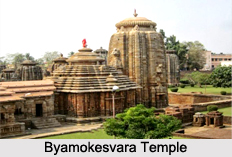 Byamokesvava temple, also referred to as Suresvara Mahadeva temple, is situated in the Tala bazaar market complex, Old Town of Bhubaneshwar in the Indian state of Orissa. The presiding deity of the temple is Lord Shiva, installed in the sanctum sanctorum or the garbhagriha of the temple in a circular yonipitha. The temple is situated in front of the Lingaraja Temple at a distance of almost 10 metres across the temple on the left side. The sanctum sanctorum presently is 1.50 m below the road level.
Byamokesvava temple, also referred to as Suresvara Mahadeva temple, is situated in the Tala bazaar market complex, Old Town of Bhubaneshwar in the Indian state of Orissa. The presiding deity of the temple is Lord Shiva, installed in the sanctum sanctorum or the garbhagriha of the temple in a circular yonipitha. The temple is situated in front of the Lingaraja Temple at a distance of almost 10 metres across the temple on the left side. The sanctum sanctorum presently is 1.50 m below the road level.
Architecture of Byamokesvara Temple
Byamokesvara Temple, a religious edifice recounting the magnificence and expertise of the ancient period artisans, was constructed in the 10th century A.D. The temple facing the western side is enclosed on the northern and southern sides by shops, on the eastern side by residential buildings and private buildings and a road on the western side. The temple lay buried until recently it was recovered. The locals ascribe the temple to the Kesharis (Somavamsis). The orientation of the temple suggests that it lays buried up to the baranda portion of the bada excluding the entrance on the western side the temple.
The temple, pancharatha in plan, is adorned with a central raha flanked by pairs of anuratha and kanika pagas on either side. Byamokesvara Temple, depicting the exclusive construction techniques of the ancient period, is marked by features such as baranda and mastaka. On elevation the vimana is of rekha deul order measuring 7.00 m in height from baranda to mastaka. The gandi, devoid of any sculptural embellishment, measures 5 m while the mastaka is 2 m in height. Five flights of steps lead down into the sanctum sanctorum of the temple.
Byamokesvara Temple, primarily built using coarse grey sandstone, adopts the dry masonry style of construction technique. Exhibiting the Kalingan style of architecture, the temple depicts the stylistic development techniques assumed for the construction purpose. The magnificently decorated doorjambs further augment the beauty of the temple. The doorjamb measuring 1.72 m high x 1.30 m wide are adorned with three vertical bands while images of river goddesses can be depicted in the upper part of the door frame constructed on both sides of the navagraha slab. The architrave, measuring 1.85 m, defines the upper part of doorjambs. These have been carved with the navagrahas. Ketu is depicted as a full figure on his knees as seen in the Tirthesvara temple.
On the right side of the doorframe the image of Goddess Ganga can be located while its left side is marked by the image of Goddess Yamuna. The idols, flanked by dwarf attendants, are seen mounted on their respective vehicles with their raised inside hand holding a vase and their outside hand placed on the thigh. These bear a close resemblance to the Muktesvara temple. The hair has been stylistically designed and their brightly illuminated faces portray a soft and warm smile. On either side the base of the doorjamb are marked by Shaivite dwarapalas, with only its upper parts exposed to the onlookers.
An image of Gaja Lakshmi, installed in the lalatabimba, is seen holding two lotuses in her two hands. The goddess is flanked by images of elephants on either side.
Byamokesvara Temple has undergone repair and renovation work during which red coloured wash has been applied on the temple.
Major festivals such as Maha Shivaratri, Sankranti, Jalabhisheka are celebrated on a grand scale by the temple authorities, drawing hordes of pilgrims from different sections of the society.





















